|
Winmate M133W Rugged Tablet PC
Intel "Broadwell" powered 13.3-inch rugged tablet with full 1920 x 1080 pixel display and extensive connectivity for professional-grade Windows work out there in the field
(by Conrad H. Blickenstorfer, with photography by Carol Cotton)
There was an era not so long ago where, thanks to advances in miniaturization, most electronics got smaller and smaller. Phones and handheld computers couldn't be tiny enough, laptops got smaller and lighter, and smallish 7-inch tablets seemed destined to become the new standard. Then people realized that those tiny screes weren't very pleasant, and using Windows on a miniature display certainly wasn't. These days, phones can't be large enough, and tablets are growing as well. The 11.6-inch class is hot, and Winmate Inc. of Taiwan took it one step farther with its new 13.3-inch M133W tablet. In this article we're presenting an in-depth analysis of the big M133W.
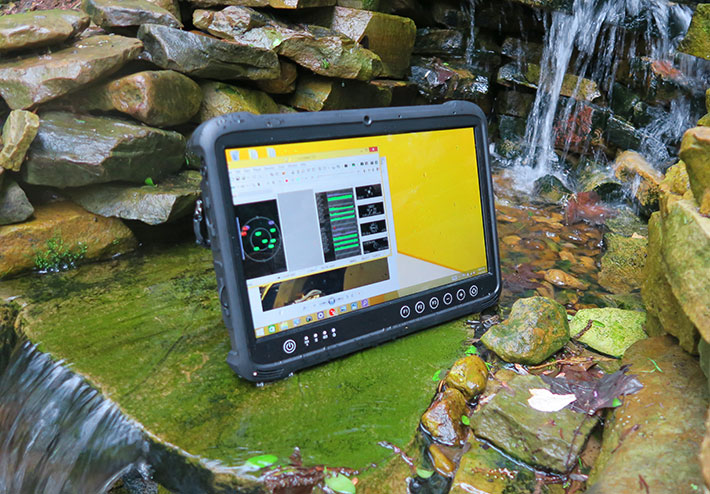
So what is the Winmate M133W? An elegantly designed modern tablet computer that's fully rugged, equipped with Intel's super-efficient 5th generation Core processor technology, a superb and satisfyingly large 13.3-inch display with full 1920 x 1080 pixel HD resolution, full ruggedness, and superb onboard connectivity.
When the company initially announced the platform late summer 2015, the media release said, "When selecting technology for use in a volatile environment, choosing between the portability of a tablet and the screen size of a laptop can be a difficult call. The larger screen size of the laptop provides greater visibility, but tablets offer greater durability and portability." The clear implication, of course, was that the Winmate M133W delivers both.
Quest for the right size and right features in a "Post PC" world
There used to be desktops and laptops and cellphones, each optimized for clearly defined sets of tasks. Work was done on the desktop. A laptop was a desktop for the road. An a phone was for making phone calls. First the smartphone and then the tablet changed all that. Desktops became considered old-school, to be replaced by ever lighter laptops. Those, in turn, were expected to be replaced by tablets. And smartphones became computers that one could also make a call on.
Problem is, the world isn't ready to be "Post PC," and smartphones and slender tablets can't do it all. So we're now in an era of finding the right tools for the job. Desktops, laptops, tablets, smartphones — each does some things well and others not so well or not at all. And the challenge is to extend the functionality of each of those platforms, to make them useful for a broader range of tasks.
The issue Winmate tackled with the M133W was creating a tablet device that is large and powerful enough to do true and real Microsoft Windows-based work. Yes, one can do Windows on a tiny screen, but not very well and not very productively. Hence this tough, rugged tablet with a screen larger than most. To provide a visual of how big the M133W is, below are, from left to right, the 5.5-inch Apple iPhone 6 Plus, the 9.7-inch iPad Air 2, the 12.9-inch iPad Pro, and the Winmate M133W with its 13.3-inch display.
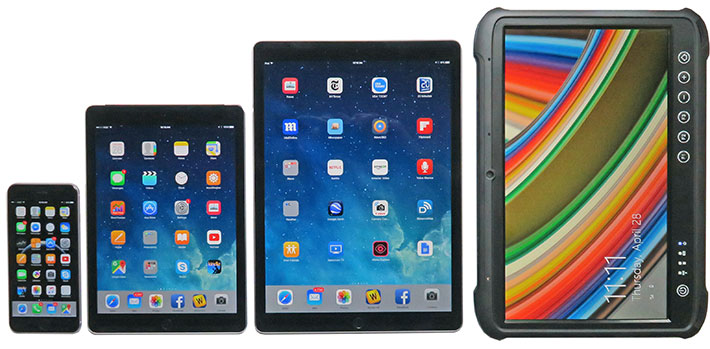
But isn't such a large tablet too bulky and heavy to really be useful in the field? That depends. The Winmate M133W has a footprint of 13.3 x 9.4 inches. That's smaller than the 14.25 x 10 inches of the 15-inch MacBook Pro we take almost everywhere. The MacBook is an inch thick, the big Winmate tablet 1.18 inches. And though the Apple laptop is a relatively fragile affair whereas the Winmate tablet definitely isn't, the MacBook actually weighs more (5.5 vs. 5.3 pounds). So Winmate's 13.3-inch tablet isn't a slender lightweight, but it isn't a boat anchor either.
Below is a look at the Winmate M133W from the front and from all four sides. It's instantly obvious that this is a rugged device with ample protection against drops, spills, and all-day use out there in the field and on the job.
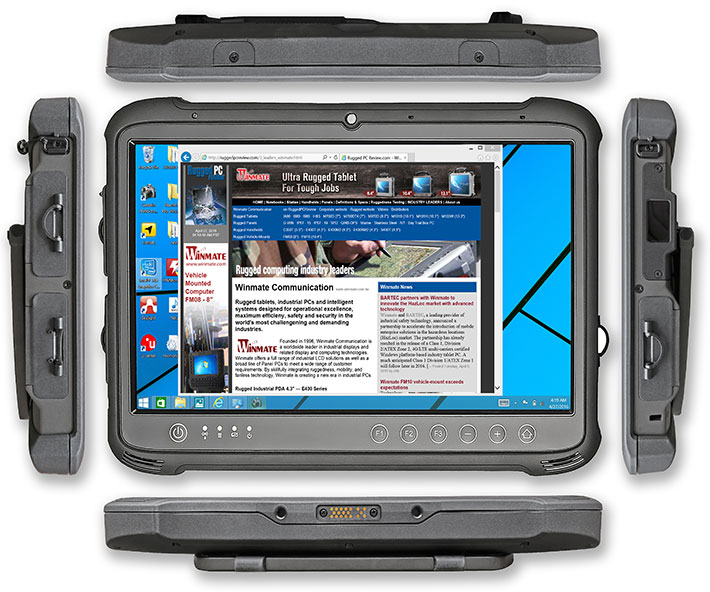
Note that while consumer tablets generally don't have more than the absolute minimum of hardware buttons, on the M133W there's a Home icon button that brings up the HotTab utility that controls the unique features of the tablet, power/sleep, three programmable function buttons that each can perform two separate functions via short or long push, as well as volume up and down control.
The below picture shows a close-up of the left side of the M133W. There are two I/O blocks on this side, each protected by a hinged rubberized plastic door with a double-lipped pressure seal. This type of door provides a very good, tight seal as long as it's firmly pushed into place. Opening is easy thanks to little pull-latches on each door.

From left to right, the lefthand I/O block provides:
- a full-size HDMI port
- a reset push-hole
- an SD Card reader
- a 3.5mm Mic In/Line Out audio jack
- two full-size USB 3.0 ports (you can always tell 3.0 because it's blue)
- a legacy DB9 RS232 serial port
The right side of the tablet, shown below, is highly configurable. Our eval unit had power, an RJ45 LAN jack, and two USB 2.0 ports underneath a protective cover, and then the window for the optional integrated 1D/2D barcode scanner. Depending on intended use, the scanner can be replaced with an also optional Smart Card reader.

A look inside the Winmate M133W
The backside of the Winmate M133W looks impressive. We're not talking just a flat, flush bottom with a couple of access doors, but a surface that's designed, structured and contoured for the various jobs at hand. it's a perfect example of form truly following function, as opposed to squeezing function into whatever form is deemed fashionable at any given point in time.
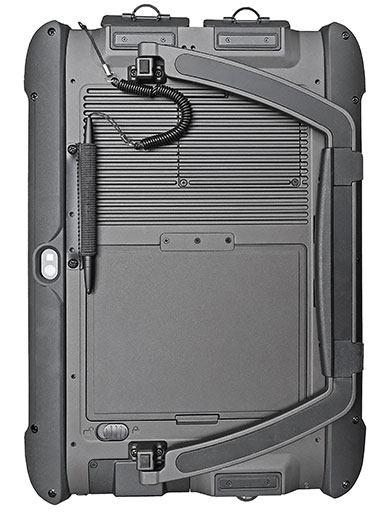 The finning in the magnesium, for example, isn't just decorative. It's there because that part of the housing dissipates processor heat, and finning increases heat-dissipating surface area. The finning in the magnesium, for example, isn't just decorative. It's there because that part of the housing dissipates processor heat, and finning increases heat-dissipating surface area.
There's the battery compartment for the flush-fitting 76.1 watt-hour (7.4 Volt, 10,280 mAh). It's rectangular, 5/8th of an inch thick, and snaps into place thanks to a springloaded lever that can then be locked via a second lever. There is no battery compartment cover or seal. Sealing to the interior of the tablet is at the point of the actual battery contacts.
The only access door on the back of the unit is a thick, heavy, finned aluminum door secured with four small screws against a pressure seal. Underneath are three expansion connectors. Two M.2 slots are for SSDs, one for a mobile broadband WWAN module. There is also a Micro-SIM card slot.
The next thing to come off are the two protective bumpers along each long side of the M133W. While they look like they are made of solid rubber, they are actually tough flexible Polymer plastic with a grippy rubberized exterior surface (most likely TPR, which stands for ThermoPlastic Rubber). In addition to providing grip and protection, they also allow Winmate to mount antennae outside the actual metal housing of the tablet, thus making for much better wireless performance.
The tough rotating kickstand of the M133W comes off easily, too. Its two anchors are secured with two Philips screws each. Note that this is one tough handle. Solid metal, with grippy rubber inserts.
Now we're down to the two halves of the M133W, and they are held together with a total of 13 Philips screws. Once those are undone, the overall construction of the M133W is revealed. The backside "bucket" is very substantial cast magnesium. The front is essentially the ABS+PC bezel with a metal plate (aluminum, it seems) attached to it. The front side of the metal plate mounts the display, the back side 6 x 5.5 inch (155 x 140 mm) the main circuit board that's roughly mini-ITX size.
Below you can see the very strong cast magnesium on the left, and the Polymer top with all of the electronics and the display on the right:
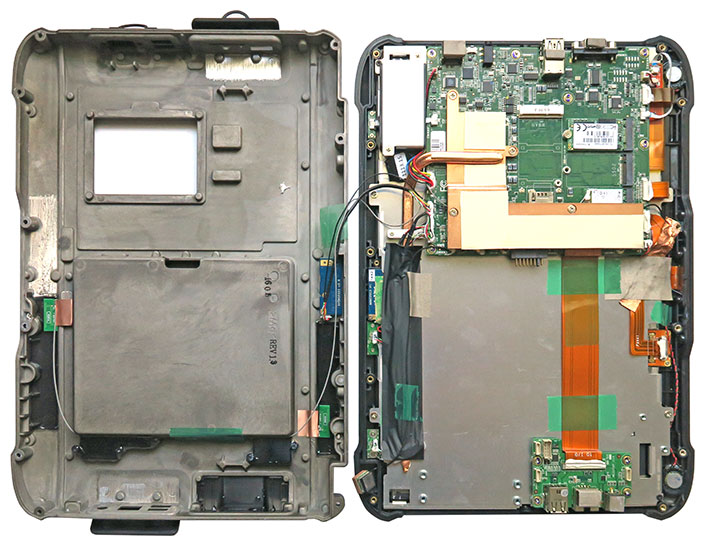
The sealing between the two halves is via a rather delicate tongue-and-groove design that relies on a very thin rubber string seal that goes around the entire perimeter of the tablet, loosely sitting in its groove. This means that when taking the tablet apart, utmost attention must be given to that seal so that upon reassembly it isn't crimped or damaged.
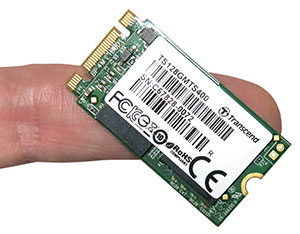 Our test unit came with one TS128GMTS400 SATA III 6GB/second 128GB solid state disk module from Transcend. It's a tiny thing that measures just 1.65 x 0.87 x 0.14 inches. It can be used as just mass storage, or — thanks to Intel Smart Response Technology — it can be configured as cache memory between a large capacity hard disk and system RAM, thus rendering a hard disk into a hybrid drive that incorporates both drive's capacities. And note that equipped with dual 128GB SSDs, the M133W can be configured for RAID 0 striping (with potentially significant performance enhancements) or RAID 1 mirroring operation. Both are configurable in the tablet's BIOS. Our test unit came with one TS128GMTS400 SATA III 6GB/second 128GB solid state disk module from Transcend. It's a tiny thing that measures just 1.65 x 0.87 x 0.14 inches. It can be used as just mass storage, or — thanks to Intel Smart Response Technology — it can be configured as cache memory between a large capacity hard disk and system RAM, thus rendering a hard disk into a hybrid drive that incorporates both drive's capacities. And note that equipped with dual 128GB SSDs, the M133W can be configured for RAID 0 striping (with potentially significant performance enhancements) or RAID 1 mirroring operation. Both are configurable in the tablet's BIOS.
The overall interior design approach very much reminds of Winmate's history and experience in embedded systems where "embedded" PC boards are used in all sorts of settings and connected to all sorts of dedicated peripherals and functionality. Here, this means that one part of the M133W tablet's I/O is surface-mounted on the system board, whereas the other part sits on a daughterboard all the way on the other side of the device. This approach means that Winmate can very easily customize I/O.
Given the substantial punch of the M133W's Broadwell Core processor, we fully expected this Winmate tablet to have a fan, but it doesn't. This, of course, requires advanced thermal management which here consists of an extensive copper heat spreader that conducts heat into the tablet's massive magnesium AND a substantial 12-inch copper heatpipe that routes heat into the tablet's internal metal mounting plate.

The pictures above show some interesting details of the M133W. On the left is a close-up of the unit's bridge battery that allows for hot-swapping. It's a 7.4V, 340mAH, 2.52 watt-hours Li-Polymer design that Winmate says provides a good five minutes of charge for swapping the main battery. Also visible are both the copper heat spreader pipe and plate. In the center is the tiny camera module that includes a fairly powerful LED flash. And on the right is one of many examples of using silicon glue to secure connectors from coming loose under severe impact or vibration.
And, as is expected in a next-gen tablet, there's a full complement of sensors. An ambient light sensor, G-sensor, gyrometer, and e-Compass are all present and ready for duty in new-era tablet apps and solutions.
Broadwell, Haswell, or Bay Trail, that is the question
Settling on the right processor, or processor options, in a new device is never simple. Initially, Winmate envisioned an all "Broadwell" 5th generation Core processor lineup that included the Intel i5-5200U and the i5-5350U. With Broadwell, Intel in essence took its impressive "Haswell" 4th generation and 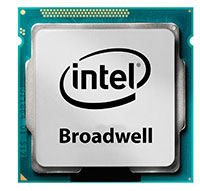 miniaturized it further, from 22nm to 14nm. That meant room for even more transistors, and Intel used some of those to enhance integrated graphics performance yet again. The optional i5-5350U differentiated itself with twice the number of graphics execution units, as well as inclusion of a number of special Intel technologies. miniaturized it further, from 22nm to 14nm. That meant room for even more transistors, and Intel used some of those to enhance integrated graphics performance yet again. The optional i5-5350U differentiated itself with twice the number of graphics execution units, as well as inclusion of a number of special Intel technologies.
While going all-Broadwell was an exciting strategy, it was also a costly one, and for a while Winmate leaned towards going with more conventional Intel Haswell and Bay Trail processors as that would have been a less expensive approach. But it would also have meant a new product without up-to-date processor technology and so, until very shortly before final product release, Winmate was going with offering the best of both worlds, by making available both 5th gen Broadwell and 4th gen Haswell Core i5 processor options, and also an economical Haswell Celeron chip. In the end, however, what made most sense was to settle on a single processor, that being the Intel "Broadwell" Core i5-5200U.
To provide an idea of where the Winmate M133W stands in terms of performance, we ran our evaluation unit through our standard benchmark suites, those being PassMark and CrystalMark. To provide some perspective of where Winmate's big-screen tablet platform fits in we're also showing the numbers of Winmate's 10.1-inch M101H and M101B tablets, as well as three competing large-screen tablets, those being the 11.6-inch Gammatech R11 and 2ns gen Getac F110, and the 12.5-inch Motion R12 by Xplore Technologies. And here is what we found:
|
Winmate M133W Benchmarks and Comparisons (PassMark 6.1)
|
|
PERFORMANCE COMPARISON
|
Winmate
|
Winmate
|
Winmate
|
GammaTech
|
Getac
|
Xplore
|
|
Model (version tested)
|
M133W
|
M101H
|
M101B
|
R11
|
F110
|
Motion R12
|
|
Device Type
|
Tablet
|
Tablet
|
Tablet
|
Tablet
|
Tablet
|
Tablet
|
|
Display
|
13.3" 1920 x 1080
|
10.1" 1920 x 1200
|
10.1" 1920 x 1200
|
11.6 1366 x 768
|
11.6 1366 x 768
|
12.5" 1920 x 1080
|
|
Processor
|
Intel Core
|
Intel Core
|
Intel Celeron
|
Intel Core
|
Intel Core
|
Intel Core
|
|
Processor Model
|
i5-5200U
|
i5-4200U
|
N2920
|
i5-4200U
|
i7-5500U
|
i7-4610Y
|
|
Code name
|
Broadwell
|
Haswell
|
Bay Trail
|
Haswell
|
Broadwell
|
Haswell
|
|
CPU Speed
|
2.20 GHz
|
1.60 GHz
|
1.86 GHz
|
1.60 GHz
|
2.40 GHz
|
1.70 GHz
|
|
CPU Turbo/Burst
|
2.60 GHz
|
2.00 GHz
|
2.66 GHz
|
2.16 GHz
|
NA
|
NA
|
|
Cores/Threads
|
2/4
|
2/4
|
4/4
|
4/4
|
4/4
|
4/4
|
|
Thermal Design Power (TDP)
|
15 watts
|
15 watts
|
7.5 watts
|
15 watts
|
15 watts
|
11.5 watts
|
|
Intel Graphics
|
HD 5500
|
HD 4400
|
HD Graphics
|
HD Graphics
|
HD Graphics
|
HD Graphics
|
|
Installed storage
|
128GB SSD
|
64GB SSD
|
64GB SSD
|
128GB SSD
|
128GB SSD
|
128GB SSD
|
|
CPU Mark
|
3,538.4
|
2,190.2
|
1,999.8
|
3,120.3
|
3,864.1
|
3,569.1
|
|
2D Graphics Mark
|
461.3
|
316.1
|
147.0
|
480.2
|
514.7
|
501.6
|
|
Memory Mark
|
981.3
|
588.9
|
396.3
|
1,063.0
|
1,215.6
|
1,222.4
|
|
Disk Mark
|
2,887.8
|
3,369.9
|
2,045.0
|
2,507.2
|
3,790.4
|
2,243.7
|
|
3D Graphics Mark
|
321.5
|
307.8
|
121.5
|
337.9
|
399.1
|
410.1
|
|
Overall PassMark
|
1,812.7
|
1,452.5
|
1,055.4
|
1,643.1
|
2,140.1
|
1,751.8
|
|
ALU
|
41,977
|
26,408
|
26,407
|
37,197
|
45,208
|
41,840
|
|
FPU
|
39,976
|
25,568
|
22,883
|
35,908
|
41,610
|
39,598
|
|
MEM
|
28,556
|
24,863
|
18,836
|
29,269
|
30,389
|
43,164
|
|
HDD
|
33,994
|
44,178
|
36,656
|
36,228
|
41,405
|
37,594
|
|
GDI
|
14,409
|
9,168
|
4,680
|
14,726
|
16,218
|
15,891
|
|
D2D
|
6,815
|
6,910
|
3,581
|
7,015
|
6,438
|
7,000
|
|
OGL
|
10,106
|
7,649
|
3,331
|
10,789
|
10,543
|
11,732
|
|
Overall CrystalMark
|
175,833
|
144,744
|
116,374
|
171,132
|
191,811
|
196,819
|
The results are interesting and require some commentary. For example, while just a few years ago a new generation of Intel Core processors always meant a big step up in performance, differences between CPU generations are more subtle now. The primary difference, as stated, between 4th generation "Haswell" and 5th generation "Broadwell" is that Intel yet again shrank its lithography from 22nm to 14nm, thus further increasing efficiency and reducing cooling needs, and enabling an even larger number of transistors on an even smaller package. 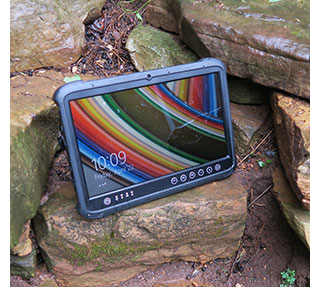 In terms of actual CPU performance, the difference isn't much. Depending on the chip and memory size, Broadwell can deliver improved graphics (an article by notebookcheck.net suggested that Broadwell graphics performance greatly benefits from more RAM (see here)). In terms of actual CPU performance, the difference isn't much. Depending on the chip and memory size, Broadwell can deliver improved graphics (an article by notebookcheck.net suggested that Broadwell graphics performance greatly benefits from more RAM (see here)).
Note the large difference between the M133W and the M101H. This seems to highlight the power of the Broadwell chip in the newer tablet. However, that M101H tester was a pre-production model that almost certainly had turbo mode turned off. A more valid comparison would be M133W vs. GammaTech R11.
How about comparing the M133W with the Getac F110 which has an i7-5500U chip with a higher clock speed? Here the difference is surprisingly small, especially considering that the F110 needs a fan for cooling and the M133W doesn't. Xplore's Motion R12 tablet went another route, using a super-low voltage Y-Series chip that benchmarked close to the M133W's i5-5200U. The thing here is that Y-Series chips can't generally maintain full performance once they get hot.
As is, overall, the Core i5-5200U-powered M133W is a very competent performer that scores high both on sheer punch as well as on battery life (see below). And the fact that it performs so well without a fan may be a big plus with some customers. Fans today are very reliable and can even run underwater, but they still make noise and represents something that can break.
Modest power consumption
Back in the day, laptop computer users were happy to get two or three hours of runtime on a charge. And ditto for users of early Tablet PCs. That all changed with the iPad that lasted 10 hours between recharging. Today, full-shift operation and more is expected from most mobile computing devices. This makes designing mobile computers an exercise in compromise with careful balancing of size, weight, performance, cost and battery life. It also requires good market research and a good deal of guessing: Will a big battery that lasts ten hours make the device too thick and heavy? Will a lighter design with a smaller battery lead to complaints over insufficient battery life?
Such contemplations are perhaps a bit less of an issue when designing an inherently large device, such as a fully rugged tablet with a big 13.3-inch display. As is, Winmate played it safe with the M133W. It's a big tablet, but it's still only 1.2 inches thick. That's in part made possible by a relatively slender battery. But that battery still packs 76 watt-hours — almost twice that of the battery in the M101H — and that should be enough for a tablet with an ultra-low power processor.
|
Winmate M133W Power Draws (at idle)
|
|
Backlight level
|
Lowest
|
Room
|
Maximum
|
|
Power Saver
|
5.4 watts
|
7.4 watts
|
9.4 watts
|
|
Balanced
|
6.3 watts
|
8.5 watts
|
9.7 watts
|
|
Max Performance
|
6.6 watts
|
8.7 watts
|
10.0 watts
|
Winmate claims 11 hours of operation on a charge for the M133W's 7.4 Volt, 10,280mAH Lithium-Polymer battery that fits flush into the backside of the tablet. To see if that estimate seems doable, we tested the M133W with PassMark's BatteryMon 2.1 utility and found the following:
With the tablet set to the Windows Power Saver mode, the display backlight set to its lowest, and all radios off, we saw a power draw of 5.4 watts. With the backlight set to medium and the radios on, we saw 7.4 watts, and with the backlight set to its brightest setting, power draw rose to 9.4 watts.
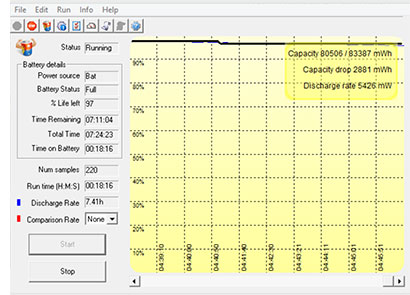 In the recommended Windows Balanced mode with radios on, the figures were almost exactly the same: 6.3 with backlight lowest, 8.5 in medium, and 9.7 watts at its brightest. In the recommended Windows Balanced mode with radios on, the figures were almost exactly the same: 6.3 with backlight lowest, 8.5 in medium, and 9.7 watts at its brightest.
In the Windows Max Performance setting, we found a low of 6.6 watts at the lowest backlight, 8.7 watt with average backlight, and 10.0 watts with the backlight at its highest. Exercising the tablet by running 1080p MP4 video, we saw an average of 16 watts.
Dividing the battery's 76 watt-hours by the lowest draw we saw (5.4 watts) yields a theoretical battery life of 14 hours. Dividing it by the highest draw we saw (16 watts) indicates still 4.75 hours. This range seems quite reasonable for a full-size rugged tablet, and especially so if it's equipped with a quickly replaced and hot-swappable battery.
Interestingly, the Broadwell-powered Winmate M133W minimum draws we recorded were actually lower than those we found not only on the much lower-performance Bay Trail-powered Winmate M101B, but also the minimum draws of several Intel Atom-powered devices. That doesn't mean that powerful Core processor machines now use less battery than miserly Atom chips. When pushed to the limits, the Core-powered device will have a much higher draw. But the increasingly sophisticated power conservation features of Core processors mean that they are great a conserving battery power when it is not needed..
Azimuthal Anchoring Switching (AAS) display technology
When we reviewed Winmate's smaller M101H tablet, we had the highest praise for its terrific Hydis HFFS display. HFFS (High Performance Field Fringe Switching) was an evolution of Hydis' excellent AFFS display technology that impressed us for years with its brilliance and full 180-degree viewing angle from all directions. Unfortunately, Hydis, now part of E-Ink, has hit some hard times, and so Winmate, intent on maintaining its high display quality standards, went to Innolux for the M133W's screen.
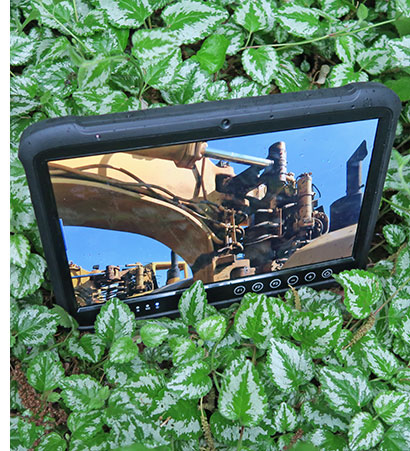 The M133W uses a 13.3-inch display based on the Innolux Azimuthal Anchoring Switching, or AAS, technology that combines the excellent viewing angles of IPS displays with the resistance to color shifts of twisted nematic (TN) cell designs. From what we understand, Azimuthal Anchoring Switching improves accuracy of certain operations within the LCD that then result in better electro-optical properties. Luminance is 350 nits, which is only half that of the M101H display, but still significantly more than the 200-250 nits of your average laptop. The M133W uses a 13.3-inch display based on the Innolux Azimuthal Anchoring Switching, or AAS, technology that combines the excellent viewing angles of IPS displays with the resistance to color shifts of twisted nematic (TN) cell designs. From what we understand, Azimuthal Anchoring Switching improves accuracy of certain operations within the LCD that then result in better electro-optical properties. Luminance is 350 nits, which is only half that of the M101H display, but still significantly more than the 200-250 nits of your average laptop.
The M133W offers full 1080p resolution. That's 165 dpi (dots per inch) and makes for a very crisp and sharp picture. 165 dpi is sharper than the current class of 11.6-inch rugged tablets, most of which have 1366 x 768 pixel resolution, which makes for only 135 dpi. It's also much sharper than a 13.3-inch MacBook Air and virtually all non-retina desktop displays. Viewing angle is 89 degrees from all sides, which means it's for all practical purposes perfect. There are no color or contract shifts, which is huge.
Since tablets like the Winmate M133W will be used in vehicles, outdoors, and sometimes in direct sunlight, they must be viewable and readable under a wide variety of lighting conditions. Outdoor-viewable display technology has come a long way in the last few years, generally using a combination of transmissive LCDs (for vibrant indoor viewing), a variety of optical treatments (for maximizing contrast outdoors), and a strong backlight (to boost contrast as much as possible).
In everyday use, the M133W display is terrific. It's sharp enough for almost any use although individual pixels, unlike in "retina" displays, are still visible. It's bright and vibrant. The viewing angle is indeed perfect. There are no color of contrast shifts. The is a slight darkening of the image when viewed from extreme angles.
To see how well it works outdoors, we compared the Winmate M133W with an Apple iPad Pro whose formidable 2732 x 2048 12.9-inch direct-bonded display is said to have a luminance (can really be regarded as backlight strength) of about 425 nits. Placed side by side outdoors on a bright April day in a semi-shaded area, both displays appeared bright and vibrant, with the Winmate display actually looking a bit brighter than the iPad Pro.
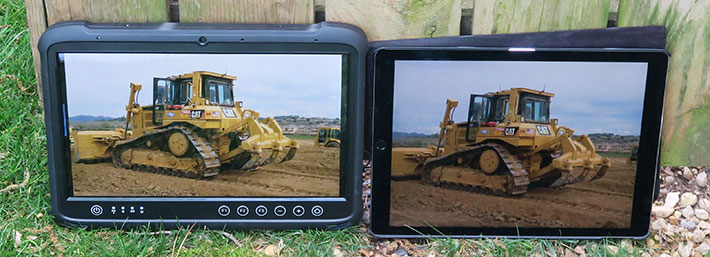
The second picture below shows the two devices from an angle. Since both displays have glossy surfaces, both are prone to reflections. Unlike the M101H which had a wide reflective bezel, the M133W doesn't have such a bezel and reflections are limited to the actual LCD area. And whereas the M101H assumed a bit of a yellow tinge when viewed from certain angles, the M133W had no so such problem.

Advanced capacitive multi-touch
The Winmate M133W uses projected capacitive multi-touch, the effortless touch technology the world has come to love and demand due to the effortless tapping, panning, zooming and pinching the technology allows. Only a short time ago, however, capacitive touch was considered unsuitable for rugged devices because outdoors it can get wet and users may wear gloves, neither of which standard capacitive touch can handle.
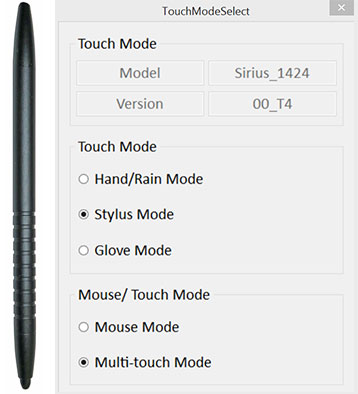 During the development process of the M133W, Winmate initially appeared to stick with a resistive digitizer, the rationale being that, in addition to the rain and gloves issues, even today a stylus on a resistive touch display offers more precision than capacitive touch. During the development process of the M133W, Winmate initially appeared to stick with a resistive digitizer, the rationale being that, in addition to the rain and gloves issues, even today a stylus on a resistive touch display offers more precision than capacitive touch.
Eventually, Winmate decided to go with a projected capacitive multi-touch digitizer, but an advanced, modified one that addresses use with gloves and in the rain, as well as more precise stylus operation.
The image to the right shows the M133W's touch mode selection control panel. This allows users to put the tablet into three different touch modes.
- Default is the Hand/Rain mode which is designed to reject "false" inputs from rain drops or liquids in general.
- Stylus mode allows the tablet to sense the fine-tipped 4.75-inch capacitive stylus that comes with the M133W. The stylus and tip are metal and enable far more precise operation than is possible with standard broad-tipped capacitive styli. Regular finger touch remains available in this mode.
- Glove mode allows operating the display with some gloves, depending on material and thickness.
Note that these modes all operate within the constraints of mutual capacitance technology, by tweaking controller sensitivity and applying selective filters. This means there are limits to what can be done. For glove use, we also recommend looking into gloves with integrated capacitive touch enablers in thumb and index fingers, or third-party capacitive touch glove contacts, like the ones from GloveTacts.
The touch mode selection control panel also allows users to pick either "mouse mode" for single touch and a mouse pointer, or the default "multi-touch" mode without mouse pointer and up to ten simultaneous touches.
There is one thing about the M133W to get used to: in almost all capacitive multi-touch devices, the frontal glass extends over the entire frontal surface of the device, or at least a good way past the perimeter of the actual LCD. The M133W, however, has a raised 1/8-inch bezel right along the LCD perimeter, which can make it difficult to do precise touch operations near the perimeter of the LCD.
And the usual procap caveat here: while capacitive multi-touch has become the de-facto standard for smartphones and tablets, legacy Windows with its small check boxes and narrow scrollers was clearly designed for use with a mouse. This can, in part, be addressed by optimizing the legacy Windows user interface in Windows 7 (see RuggedPCReview's how-to) or in Windows 8.1 via the Registry Editor (see here). Winmate also makes some recommendations on optimizing the user experience via customization for each offered version of the Windows operating system in the M133W manual.
Overall, capacitive multi-touch worked flawlessly on the big M133W, with none of the hesitation that earlier Windows-based hardware often exhibited with procap. And being able to switch between modes and selecting the optimal one for any given environment is much appreciated. Finally, the excellent narrow-tip pen and the large display both add greatly to making the M133W pleasant to use, something that in the past was never a given for Windows operation without a mouse.
Dual cameras
The Winmate M133W has two integrated cameras. The user-facing 2mp camera is for video conferencing, whereas the rear-facing 5mp camera with LED flash can be used for documentation purposes, both stills and video.
Cameras integrated into handheld and tablet computers have historically underperformed compared to even low-end dedicated cameras as well as the cameras available in virtually every smartphone. In the last two or three years, the quality of cameras integrated into mobile computers has somewhat improved, but generally not enough to eliminate the need of taking along a dedicated camera or smartphone if suitable photo or video documentation is needed on the job.
The overall idea of adding cameras to workforce-grade tablets is so that their users can document whatever they are working on without the need for an additional camera. This way, everything is in one system. And having a nice, large tablet screen to view pictures is certainly is a lot more pleasant than the tiny screens on dedicated cameras or even smartphone displays (see below). And having all project-related information — work order, status inventory, work performed, images, video — all in one place is certainly attractive. Can the M133W's cameras deliver? For now, the answer is "possibly."
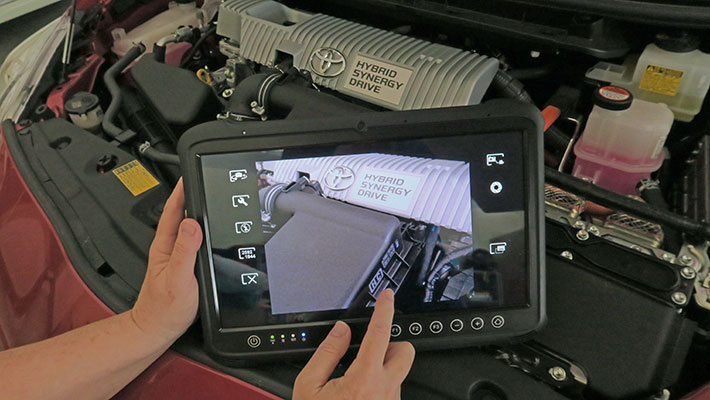
Why can't we make a more authoritative statement? Because our review unit was still a late beta and not the final shipping version. As is, the documentation camera in the M133W managed was capable of shooting very decent pictures in resolutions up to 2592 x 1944 pixels. We used Winmate's own camera instead of Windows 8.1's super-basic version. The Winmate camera has a few more settings, albeit nowhere near as many as modern smartphone cameras, let alone dedicated consumer cameras. We shot in the highest 2592 x 1944 resolution and in "best" quality mode.
The overall results were much like what with found with the 5mp camera in an earlier Winmate tablet we tested (the M101H). Auto-focus is slow, especially in sub-optimal lighting conditions, and you can't tell the camera what to focus on. Once it latches on, images are usually sharper than expected, and the camera does not compress images so much that they become useless. In fact, in that respect it's significantly better than most mobile computer cameras. Some pictures had a very distinct purple/green tint that required post-processing.
Below are pictures shot with the M133W camera in 2592 x 1944 resolution. To see the compilation in full-size in a separate window, click on the picture below.

Documentation camera video worked fine, although we could only record in 640 x 480 whereas the camera ought to be able to shoot in 1080p. Recordings were without glitches or hiccups, though the autofocus frequently hunted.
Overall, the M133W documentation camera is inherently capable of shooting very decent pictures. They may require some post-processing, but they are usable for documentation since the camera has good sharpness and doesn't over-compress. The camera app, though, is very limited, and we hope Winmate will either make the app faster and more complete, or use a dedicated 3rd party camera app. It seems quite unclear why every Android device has a superb camera app whereas the same cannot be said of Windows.
Ruggedness
Winmate describes the M133W tablet as "rugged" and with its tough PC+ABS and magnesium case and overmolded TPR corner protection it certainly looks much tougher than all those ever thinner and ever more fragile consumer tablets.
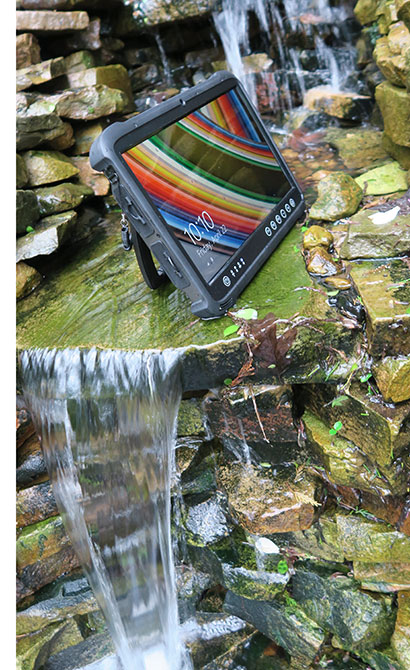 Environmental specs include a fairly wide 14 to 122 degree Fahrenheit operating temperature range (-10 to 50 degrees Centigrade). That's a few degrees less than the M101H on both ends of the spectrum, but it's still enough to deploy the M133W almost anywhere.
Environmental specs include a fairly wide 14 to 122 degree Fahrenheit operating temperature range (-10 to 50 degrees Centigrade). That's a few degrees less than the M101H on both ends of the spectrum, but it's still enough to deploy the M133W almost anywhere.
The tablet can handle 26 repeated drops from four feet per MIL-STD-810G, 516.6 IV to plywood over concrete. That's relevant because four feet is roughly the height a tablet is held while it's being operated when standing or walking. It's also remarkable for a tablet as large as this, and a testimony to the tablet's solid construction and excellent exterior protection via rubber bumpers.
Sealing is at the IP65 level. That means the Winmate M133W is totally protected against dust, and it can also handle low pressure water jets from all directions, albeit with limited ingress permitted. That means that as long as all seals are in good working conditions and the protective door over the I/O block is closed, the M133W should easily survive even a downpour. It certainly didn't mind sitting in our proving ground brook and waterfall for half an hour.
The picture below shows our evaluation M133W sitting in running water. Do make sure, however, to tightly close all the protective covers before this sort of abuse, and also note that the capacitive touch screen becomes inoperable while water is running over it or when it sits in water. It works in a bit of rain, but only to a certain extent.
Winmate also claims successful shock testing in accordance with the methods described in MIL-STD-810G 516.6 Procedure I and vibration testing per MIL-STD-810G Methods 514.6 Procedure I.
For a rugged mobile computer system in this class, we'd like to see more extensive ruggedness tests and a link to the actual ruggedness testing results. We're certain prospective customers would appreciate that.
Overall, there's no doubt that the Winmate M133W is far tougher and far more durable than than any consumer or even enterprise market tablet. It feels solid and substantial, the protective covers are both easy to close and to close, there's nothing to break off, and even the excellent optional stand/handle seems built to last forever.
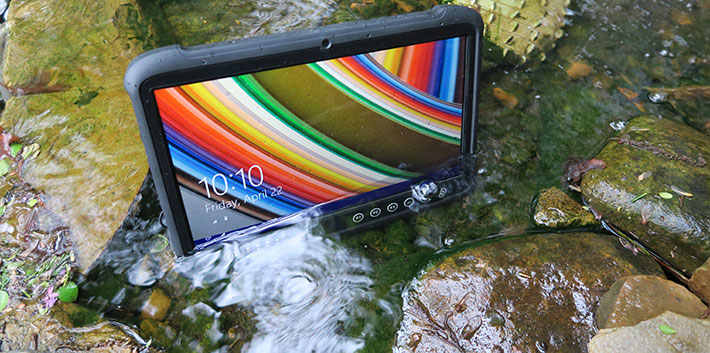
Bottom line: Winmate M133W
With the new M133W, Winmate has recognized the growing demand for larger tablet displays with higher resolutions in packages that take advantage of the latest Intel has to offer. Very obviously, the company also understands the importance of sufficient onboard connectivity, good industrial design, and compelling ergonomics.
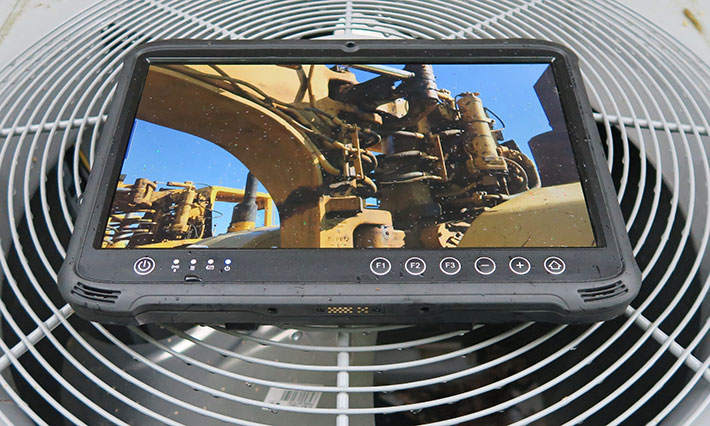
Just as Microsoft (Surface Pro 4) and Apple (iPad Pro) launched a "professional" class of more powerful tablets with larger displays primarily designed for the enterprise market, Winmate is bringing these benefits into industrial and other heavy-duty markets with the M133W. Professional-grade ruggedness and functionality, of course, come at the price of higher weight and a less slender profile. Weighing 5.3 pounds and being 1.2 inches thick,
the M133W is a substantial piece of equipment, albeit one that remains surprisingly handy and easy to use.
On the performance front, our Core i5-5200U equipped evaluation unit was quick and yet remarkably easy on its hot-swappable battery. And thanks to advanced thermal management, the M133W does not need a fan.
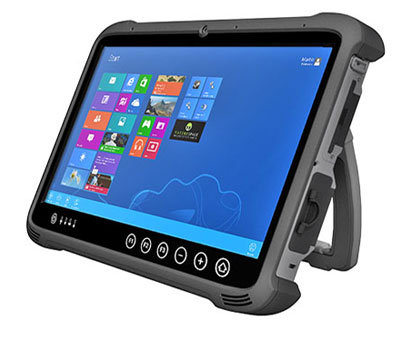 The M133W impresses with its large 13.3-inch 1920 x 1200 pixel display. It's bright, crisp, offers a virtually perfect viewing angle from all directions, and shows absolutely no annoying color or contrast shifts. Capacitive multi-touch works especially well with Windows on this large display, which can also be optimized for use with gloves, in the rain, or with the supplied narrow-tip stylus. The M133W impresses with its large 13.3-inch 1920 x 1200 pixel display. It's bright, crisp, offers a virtually perfect viewing angle from all directions, and shows absolutely no annoying color or contrast shifts. Capacitive multi-touch works especially well with Windows on this large display, which can also be optimized for use with gloves, in the rain, or with the supplied narrow-tip stylus.
Onboard connectivity includes USB 2.0 and 3.0, HDMI, LAN and serial, all in standard size versions. The device has an optional industrial-grade integrated 1D/2D imager, and also has reasonably competent cameras suitable for documentation tasks in a pinch.
Thanks to its PC+ABS/die-cast magnesium construction and protective rubber overmoldings, the Winmate M133W is extremely solid and can handle a good deal of abuse. IP65 sealing means M133W users won't have to shy away from rain, and the tablet has a suitably wide operating temperature range. However, we'd like to see more comprehensive ruggedness specs.
Offering good performance, full-shift-plus battery life, a gratifyingly large and truly terrific hi-res display, and remarkable ruggedness, the Winmate M133W represents a compelling package for numerous applications that not only require Windows in the field, but also enough screen real estate for professional-grade applications. -- Conrad H. Blickenstorfer, May 2016
Winmate M133W Rugged Tablet PC Specs:
| Type |
Large-screen rugged Tablet PC |
| Status |
Added 08/2015, full review 04/2016
|
| Processor |
2.20GHz Intel Broadwell Core i5-5200U (turbo 2.70GHz)
|
| Graphics |
Core i5-5200U: Intel HD Graphics 5500
|
| CPU Thermal Design Power |
Core i5-5200U: 15 watts
|
| OS |
Windows 10 IoT Enterprise
Windows Embedded 8.1 Industry Pro 64-bit
Windows Embedded Standard 7 (WS7P) 64-bit
Windows 7 Pro for Embedded Systems 64-bit |
| Memory |
4GB to 16GB DDR3L 1600 SO-DIMM
|
| Display |
Sunlight-readable, optically bonded 13.3" FHD (1920 x 1080 pixel 166 ppi) AAS/IPS TFT with 350 nits LED backlight and 89° viewing angle from any direction |
| Digitizer |
Projected capacitive multi-touch with glove/rain/stylus modes |
| Keyboard |
Onscreen keyboard |
| Navigation |
Stylus, touch |
| Storage |
128GB M.2 MLC SSD (up to 1TB with 2 x SSD), 2 x internal M.2 slots
|
| Expansion slots |
1 x SD card, 1 x SIM card, 2 x internal M.2 slots |
| Housing |
Rear: die-cast magnesium alloy, all-around elastomeric rubber |
| Size |
13.3 x 9.4 x 1.18 inches (338 x 240 x 30 mm) |
| Weight |
5.3 lbs. (2.4 kg)
|
| Operating temperature |
14° to +122°F (-10° to 50°C) |
| Humidity |
30% ~ 80% (non condensing) |
| Ingress protection |
IP65 |
| Altitude |
Unknown
|
| Drop/shock |
MIL-STD-810G, 516.6 VI: 4-foot drop, over concrete, onto each edge, face and corner (26 drops total) |
| Shock (with SSD) |
MIL-STD-810G, 516.6 Procedure I
|
| Salt Fog |
Unknown |
| Vibration |
MIL-STD-810G, 514.6 Procedure I |
| Power |
Hot-swappable Li-Polymer 7.4V, 10,280mAH, 76.1 watt-hours ("11 hours"), 5-minute hot-swapping capability via Li-Polymer 7.4V, 340mAH, 2.52 watt-hours bridge battery
|
| Cameras |
2mp camera front, 5mp camera with LED flash rear (up to 2592 x 1944 pixel) |
| Sensors |
Light, G-sensor, Gyrometer, e-Compass
|
| Scanning |
Optional: short range 1D/2D Motorola SE4500 barcode reader, HF RFID 13.56MHz reader (ISO15693, ISO14443A, ISO18092)
|
| Interface |
1 x HDMI, 2 x USB 3.0, 2 x USB 2.0, 1 x RS232, 1 x RJ45, audio, power, dock
|
| Wireless options |
Dual-band Intel 7265 802.11ac (M.2), Class I Bluetooth 4.0 dual-mode, u-blox Neo-6Q GPS, optional 3G WWAN or 4G LTE
|
| Price |
Inquire |
| Contact |
Winmate Inc. |
| Product page |
Winmate M133W product page |
| Brochure |
Winmate M133W specsheet (PDF) |
| Contact |
Winmate Inc.
9F, No.111-6, Shing-De Rd.,
San-Chung District, New Taipei City 241
Taiwan, R.O.C.
Tel: 886-2-8511-0288
Fax: 886-2-8511-0211 |
(copyright 2016 RuggedPCReview.com)
|



